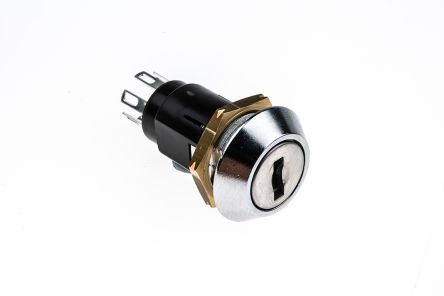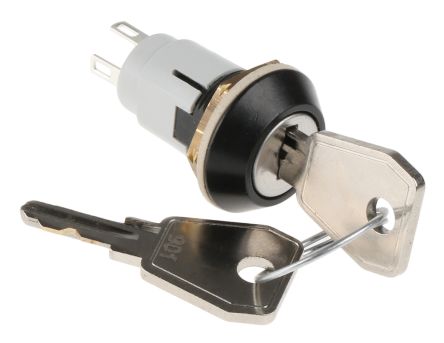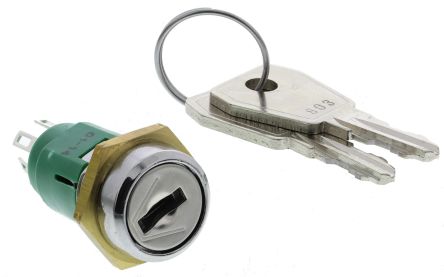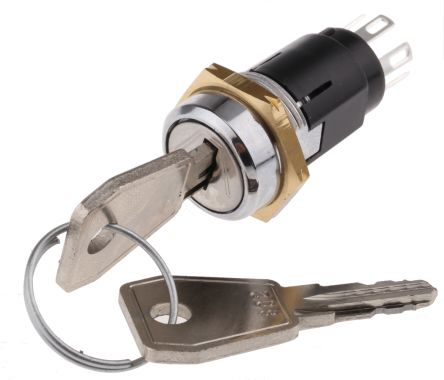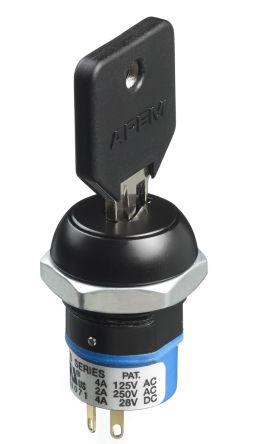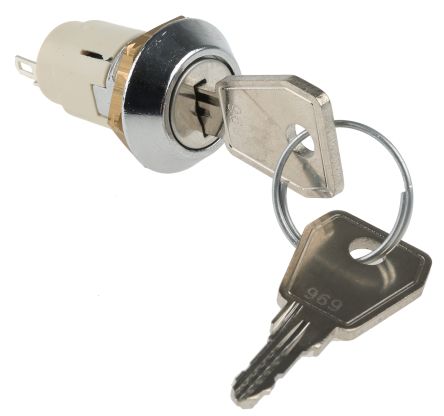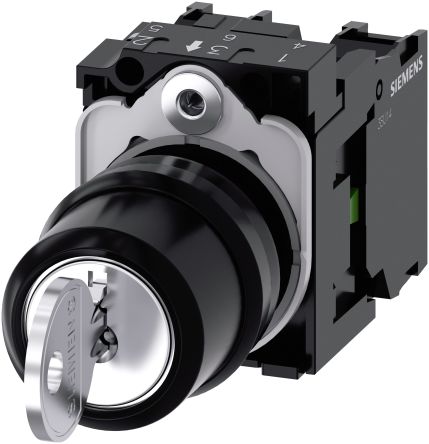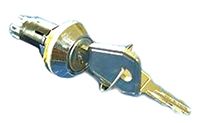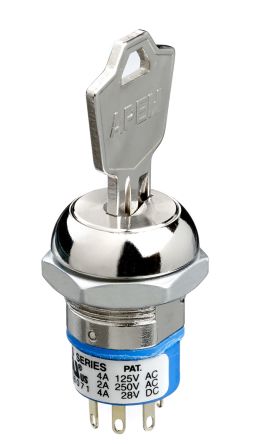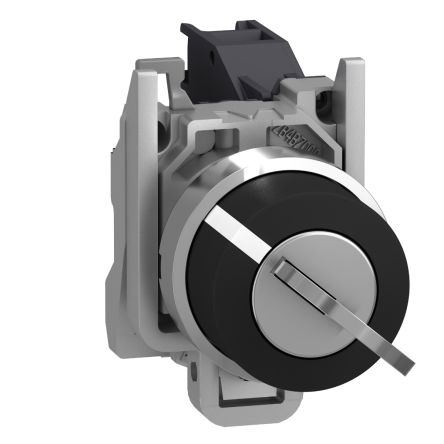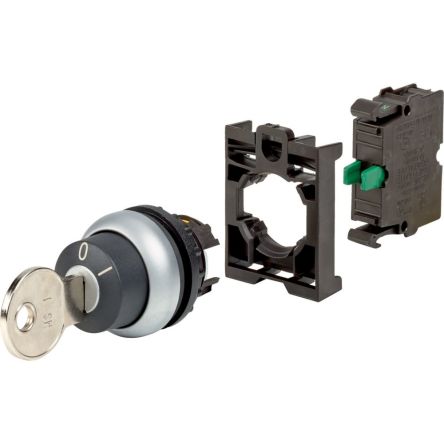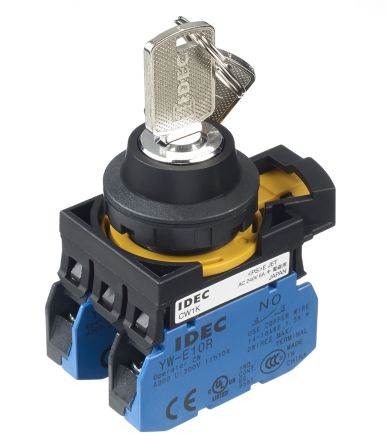- Automation & Control Gear
- Cables & Wires
- Enclosures & Server Racks
- Fuses & Circuit Breakers
- HVAC, Fans & Thermal Management
- Lighting
- Relays & Signal Conditioning
- Switches
- Batteries & Chargers
- Connectors
- Displays & Optoelectronics
- ESD Control, Cleanroom & PCB Prototyping
- Passive Components
- Power Supplies & Transformers
- Raspberry Pi, Arduino, ROCK, STEM Education & Development Tools
- Semiconductors
Key Switches
Key switches are electromechanical devices controlled by a key, offering distinct positions like 'ON' and 'OFF' for clear visual indication. This key-operated mechanism makes them ideal for enhanced safety and security, preventing accidental operation.
Beyond simple ON/OFF, common key switch configurations include:
- Momentary: Active only while the key is held, perfect for doorbells or machine starts.
- Maintained: Stays activated even after key release, ideal for power controls or equipment requiring a sustained state.
Types of Key Switches
Key switches are available in various styles to meet diverse application needs. Some of the common types include:
- Rotary Key Switches: These switches rotate the key to different positions. They are often used in applications requiring multiple positions or complex switching sequences.
- Push-Button Key Switches: These switches are activated by pushing the key. They are generally used for simple ON/OFF functions and are known for their ease of use.
- Toggle Key Switches: These switches are operated by flipping a lever or toggle. They are frequently employed in applications where a visual indication of the switch's state is essential.
Key Switches Security Features
Key switches are inherently more secure than standard switches due to the need for a physical key for operation. However, certain models incorporate additional security features to provide an even higher level of protection:
- Tamper Resistance: Tamper-resistant key switches are designed to deter unauthorised access and prevent tampering. They may include features such as concealed screws, reinforced housings, or specialised mechanisms that make it difficult to bypass the switch without the correct key.
- Unique Key Codes: Key switches can be manufactured with unique key codes, ensuring that only authorised personnel with the matching key can operate the switch. This adds an extra layer of security, particularly in applications where access control is critical.
Installation Guidelines
Proper installation is crucial for ensuring the reliable and safe operation of key switches. Here are some general guidelines to follow:
- Location: Choose an accessible location for authorised personnel, considering environmental factors.
- Instructions: Each key switch model may have specific installation requirements. Always follow the manufacturer's specific installation instructions.
- Mounting: Securely mount the switch using appropriate hardware to prevent accidental movement.
- Wiring: Connect wires to the switch's terminals, ensuring correct polarity and secure connections. Use suitable wire gauges and insulation.
- Testing: After installation, test the switch's functionality, including key operation and any additional features.
For complex installations or specific applications, consult a qualified professional to ensure proper installation and safety compliance.
What Are Key Switches Used For?
Key switches are commonly found in industrial environments, such as factories and warehouses, where they control access to critical machinery or power sources, ensuring worker safety and preventing unauthorised operation. However, their applications extend far beyond industrial settings, finding use wherever a heightened level of security is desired.
- Fire alarm systems: Key switches can activate or silence fire alarms, preventing false alarms and ensuring prompt emergency response.
- Data cabinets or servers: Sensitive data housed in server rooms or cabinets can be protected with key switches, restricting access to authorised personnel only.
- Fuse boxes: In residential and commercial buildings, key switches provide a secure way to isolate electrical circuits for maintenance or troubleshooting, preventing accidental contact with live wires.
- Processing or assembly lines: On production lines, key switches might control the start/stop functions of individual machines or entire sections of the line, ensuring coordinated and safe operation.
- Large or heavy-duty machinery: Complex industrial equipment often utilises key switches to initiate specific processes or activate safety mechanisms, safeguarding the machinery and its operators.
Beyond these typical examples, key switches find applications in various other industries, including transportation, telecommunications, and even healthcare, demonstrating their versatility and importance in ensuring security and control.
Your Trusted Key Switches Supplier & Manufacturer
RS is your go-to supplier for key switches in Australia. As a trusted and widely-used distributor, we offer an extensive range of key-operated switches from renowned brands like APEM, C & K, Lorlin, and our own RS PRO. Whether you need to buy key switches for industrial machinery, lighting control systems, security systems, electrical panel locks, or any application requiring controlled access, we have the perfect solution for you, along with a selection of button switches and emergency stop switches to meet all your electrical control and safety needs. For more details on delivery services and fees, please refer to our Delivery Page.
Popular Searches
Related links
- Mastering Key Switches: Types and Best Practices
- Selector Switches
- Lorlin Key Switch 1 A @ 24V ac dc / 115V ac 3-Way Common-Key
- Schneider Electric IP65 Key Switch, 1 NO + 1 NC 2-Way
- TE Connectivity High Security Key Switch 1 A @ 120 V ac 2-Way
- Idec IP65 Key Switch, DPST 2-Way
- Cole Hersee IP67 Key Switch, 10 A 4-Way Straight-Key
- Lorlin Key Switch 1 A @ 24 V dc 2-Way Common-Key

